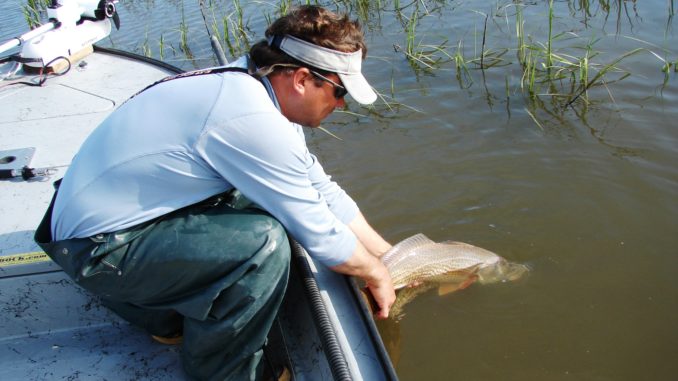
Cut mullet, cut crab working magic on cruising fish
Capt. Mark Stacy of Ocean Isle Fishing Charters said inshore fish have finally settled in to a spring pattern – despite the rapid-fire cold fronts that have been breaking them up and keeping fish and fishermen confused.
“Our inside water had warmed to 68 degrees a week ago, and things were looking almost too good,” Stacy said. “These cold fronts have dropped the water back into the low 60s, but it is warming again, just a little slower this time. It bothers the fish for at least a day, but once the sun comes back out, they gradually start biting again and in a few days are going good if the weather allows.”
Stacy said the fishing was surprisingly good considering. He is catching lots of red drum and black drum, a few speckled trout and the first of the flounder are biting too. He said the fish know it’s time to be moving and be hungry.
“One of the most interesting things we have going on right now is red drum moving into flooded sections in the marsh behind Ocean Isle and Sunset Beach,” said Stacy (910-279-0119). “These aren’t the summer and fall tailers, but fish that are moving through the flooded marsh looking for an easy meal. Except for an occasional wake or some muds when they are spooked, we’re not seeing them, but when we put out a spread of baits we usually catch a few.”
Stacy said he eases his flats boat into the grass a couple of hours into the rising tide. He said the puppy drum are moving in as soon as they can, and he has to get there early to keep from spooking them. He uses split-shot rigs and eight-ounce jigheads to cast pieces of fresh cut bait and pieces of crabs into holes and thin spots in the flooded grass. If the fish are there, they smell the baits, and it doesn’t take long to start getting strikes.
When the action slows, or if the fish don’t show, Stacy moves a short distance to another clear spot and sets up again. He said you have to be ready to set the hook as soon as the fish picks up the bait. Once the fish is on, it’s just like fighting a fish that was tailing or waking.
Most of these are upper- or over-slot reds, and you have to battle pretty hard to keep them from running your line into thick grass and cutting it on the sharp edges.





Be the first to comment